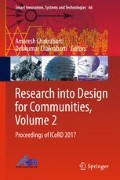Abstract
This concept paper examines the bases for the 100 smart-cities proposed in India—a partial solution is the adoption of leapfrogging technologies. It argues instead for the idea of smart-villages, like the PURA model proposed by Abdul Kalam, which could build up rural areas and mitigate migration. Better would be a scheme of open-source architecture/settlements supported by ICT, developable for rural areas; further, their inherent knowledge needs to be captured, preserved and adapted to today’s context.
Access this chapter
Tax calculation will be finalised at checkout
Purchases are for personal use only
References
World Bank data: http://www.worldbank.org/data/. Visited on 03 Mar 2016
NASSCOM: The future of Internet in India. Noida: NASSCOM (2016)
Innovations for Successful Societies, Series: Governance Traps, Interview no.: Q5, https://successfulsocieties.princeton.edu/sites/successfulsocieties/files/interviews/transcripts/3533/v._ravichandar.pdf. Visited on 18 Apr 2016
McKibbin, B.: Curitiba—A model for global development. http://www.commondreams.org/views05/1108-33.htm. Visited on 15 Apr 2016
https://www.ted.com/talks/jaime_lerner_sings_of_the_city?language=en (Mar 2007). Visited on 10 May 2016
https://www.ted.com/speakers/enrique_penalosa (Dec 2013). Visited on 10 May 2016
http://smartcities.gov.in/writereaddata/What%20is%20Smart%20City.pdf. Visited on 04 Feb 2016
McKinsey: Global Initiative. India’s urban awakening: building inclusive cities, sustaining economic growth. McKinsey & Co. (2010)
Czaika M.: Internal and international migration as a response to double deprivation: Some evidence from India, Working Papers No. 37, DEMIG project paper 7 (2011)
Datta A.: New urban utopias of postcolonial India: ‘Entrepreneurial urbanization’ in Dholera smart city, Gujarat. manuscript unpublished
Varghese P.: Exploring other concepts of smart-cities within the urbanising Indian context. In: ICETEST ‘15 Thrissur, Elsevier/ScienceDirect, Amsterdam. (2015)
http://www.ict4d.com/. Visited on 26 Aug 2016
Schön, D.A., Sanyal, B., Mitchell, W.J. (eds.): High technology and low-income communities: prospects for the positive use of advanced information technology. MIT Press, Cambridge, MA (2002)
Village information centres: harnessing local knowledge via interactive media. M.S. Swaminathan Research Foundation, Chennai, 8–9 Oct 2003
Kalam A.P.J.A., Singh S.P.: Target 3 Billion. Penguin Books, Baltimore (2011)
van Gevelt, T., Holmes J.: A Vision for smart villages (Briefing No. 5) (2015)
http://www.panchayat.gov.in/background-objectives-and-project-conceptualization
http://computer.financialexpress.com/news/harisal-a-moonshot-from-the-shadow-of-darkness-to-being-a-smart-village/18492/ (July 12, 2016). Visited on 25 Aug 2016
Sinclair, C.: http://openarchitecturenetwork.org/. Visited on 26 Apr 2016
Ratti C., Claudel M.: Open source architecture, Thames and Hudson Ltd. (2015)
https://opensource.com/life/16/5/6-open-source-architecture-projects. Visited on 26 Aug 2016
http://p2pfoundation.net/P2P/Urbanism. Visited on 28 Apr 2016
Author information
Authors and Affiliations
Corresponding author
Editor information
Editors and Affiliations
Rights and permissions
Copyright information
© 2017 Springer Nature Singapore Pte Ltd.
About this paper
Cite this paper
Varghese, P. (2017). Smart-Cities for India: Why not Open-Source Villages?. In: Chakrabarti, A., Chakrabarti, D. (eds) Research into Design for Communities, Volume 2. ICoRD 2017. Smart Innovation, Systems and Technologies, vol 66. Springer, Singapore. https://doi.org/10.1007/978-981-10-3521-0_7
Download citation
DOI: https://doi.org/10.1007/978-981-10-3521-0_7
Published:
Publisher Name: Springer, Singapore
Print ISBN: 978-981-10-3520-3
Online ISBN: 978-981-10-3521-0
eBook Packages: EngineeringEngineering (R0)

